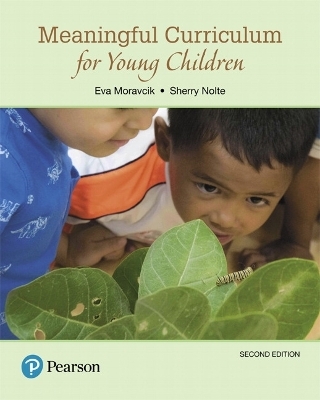
Meaningful Curriculum for Young Children
Pearson (Verlag)
978-0-13-444426-0 (ISBN)
This child-centered approach to understanding and planning curriculum focuses on humanistic and progressive education pedagogy in preschool and primary grades. The authors stress a curriculum that is joyful, has meaning to children, is built upon children’s strengths, has intellectual integrity, uses developmentally appropriate pedagogy, and encourages teachers to be passionate learners along with children. The book’s personal tone, many practical examples, step-by-step lesson planning process, and children’s art and photographs of children bring the content to life.
The new edition features updating throughout and a number of new features that add to the understanding and usefulness of the concepts, among them: Some things to say sections, end-of-section self-check digital quizzes with feedback, refreshed videos, end-of-chapter Explore and Experience sections, new children’s art and photographs of children, new improved lesson planning formats, more examples of integrated curriculum, new sections on teaching curriculum to two-year-olds, and a new connection to current national subject area standards throughout.
Improve mastery and retention with the Enhanced Pearson eText*
The Enhanced Pearson eText provides a rich, interactive learning environment designed to improve student mastery of content. The Enhanced Pearson eText is:
Engaging. The new interactive, multimedia learning features were developed by the authors and other subject-matter experts to deepen and enrich the learning experience.
Convenient. Enjoy instant online access from your computer or download the Pearson eText App to read on or offline on your iPad® and Android® tablet.*
Affordable. Experience the advantages of the Enhanced Pearson eText along with all the benefits of print for 40% to 50% less than a print bound book.
*The Enhanced eText features are only available in the Pearson eText format. They are not available in third-party eTexts or downloads.
*The Pearson eText App is available on Google Play and in the App Store. It requires Android OS 3.1-4, a 7” or 10” tablet, or iPad iOS 5.0 or later.
Eva Moravcik, is Professor of Early Childhood Education at Honolulu Community College and is coordinator of the Leeward Community College Children’s Center. Her publications include Who Am I in the Lives of Children? 10th Edition Pearson 2015, and Teaching the Code of Ethical Conduct: A Resource Guide 2nd Edition, NAEYC 2016. Sherry Nolte, is recently retired as Professor of Early Childhood Education at Honolulu Community College. Her publications include Who Am I in the Lives of Children? 10th Edition Pearson 2015.
Brief Table of Contents
Chapter 1: Curriculum that Engages
Chapter 2: Planning, Implementing, and Assessing Curriculum
Chapter 3: Integrated Curriculum
Chapter 4: Large Motor Curriculum
Chapter 5: Fine Motor Curriculum
Chapter 6: Sensory Development Curriculum
Chapter 7: Language Curriculum
Chapter 8: Literacy Curriculum
Chapter 9: Literature Curriculum
Chapter 10: Art Curriculum
Chapter 11: Music Curriculum
Chapter 12: Creative Movement Curriculum
Chapter 13: Math Curriculum
Chapter 14: Science Curriculum
Chapter 15: Social Studies Curriculum
Detailed Table of Contents
Chapter 1: Curriculum that Engages
What is Curriculum?
Sources of Early Childhood Curriculum
What Teachers Need to Know to Plan Early Childhood Curriculum
How Early Childhood Curriculum is Organized
The Process of Designing Curriculum
Chapter 2: Planning, Implementing, and Assessing Curriculum
Why do Teachers Plan?
Before You Plan
Writing an Activity/Lesson Plan
Writing Plans in the Real World
Chapter 3: Integrated Curriculum
Why Integrated Curriculum?
Models of Integrated Curriculum
Designing an Integrated Curriculum Study
Chapter 4: Large Motor Curriculum
Why Large Motor Curriculum?
Understanding Large Motor Development
What is Large Motor Curriculum in Early Childhood?
Teaching the Large Motor Curriculum
Large Motor Curriculum for All Children
Chapter 5: Fine Motor Curriculum
Why Fine Motor Curriculum?
What is Fine Motor Curriculum in Early Childhood?
Planning Fine Motor Curriculum
Fine Motor Curriculum for All Children
Chapter 6: Sensory Development Curriculum
Why Sensory Development Curriculum?
Understanding Sensory Development
What is Sensory Curriculum in Early Childhood?
Teaching Sensory Curriculum
Planning Sensory Curriculum
Sensory Curriculum for All Children
Chapter 7: Language Curriculum
Why Language?
Understanding Language Development
What is Language Curriculum in Early Childhood?
Planning Language Curriculum
Language for All Children
Chapter 8: Literacy Curriculum
Why Literacy in Early Childhood?
Understanding Literacy Development
What is Literacy Curriculum in Early Childhood Education?
Teaching Literacy
Planning Literacy Curriculum
Literacy for All Children
Chapter 9: Literature Curriculum
Why Literature?
Literature and Development
What is Literature Curriculum in Early Childhood Education?
Teaching Literature
Planning Literature Curriculum
Literature for All Children
Chapter 10: Art Curriculum
Why Art Curriculum?
Understanding Artistic Development
What is Art Curriculum in Early Childhood Education?
Teaching Art
Planning Art Curriculum
Art for All Children
Chapter 11: Music Curriculum
Why Music?
Development and Music
What is Music Curriculum in Early Childhood?
Teaching Music
Planning Music Curriculum
Music for All Children
Chapter 12: Creative Movement Curriculum
Why Creative Movement?
Development and Creative Movement
What is Creative Movement Curriculum in Early Childhood?
Teaching Creative Movement
Planning Music Curriculum
Creative Movement for All Children
Chapter 13: Math Curriculum
Why Math?
Understanding Math Development
What is Math Curriculum in Early Childhood?
Teaching Math
Planning Math Curriculum
Math for All Children
Chapter 14: Science Curriculum
Why Science?
Development and Science
What is Science Curriculum in Early Childhood?
Teaching Science
Planning Science Curriculum
Science for All Children
Chapter 15: Social Studies Curriculum
Why Social Studies?
Understanding Development and Social Studies
What is Social Studies Curriculum in Early Childhood?
Teaching Social Studies
Planning Social Studies Curriculum
Social Studies for All Children
| Erscheinungsdatum | 01.03.2017 |
|---|---|
| Sprache | englisch |
| Maße | 201 x 251 mm |
| Gewicht | 870 g |
| Themenwelt | Sozialwissenschaften ► Pädagogik ► Vorschulpädagogik |
| ISBN-10 | 0-13-444426-4 / 0134444264 |
| ISBN-13 | 978-0-13-444426-0 / 9780134444260 |
| Zustand | Neuware |
| Informationen gemäß Produktsicherheitsverordnung (GPSR) | |
| Haben Sie eine Frage zum Produkt? |
aus dem Bereich


